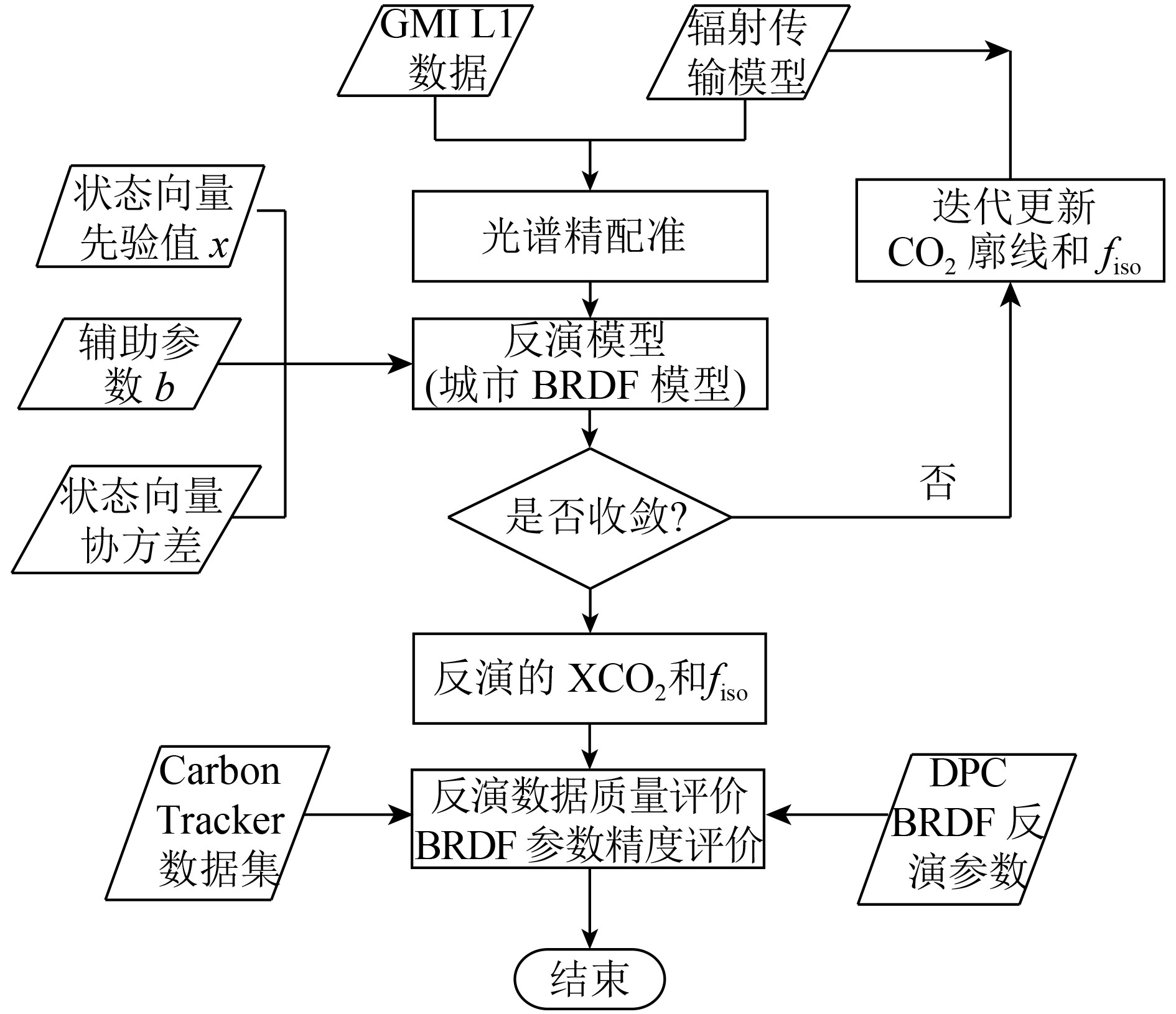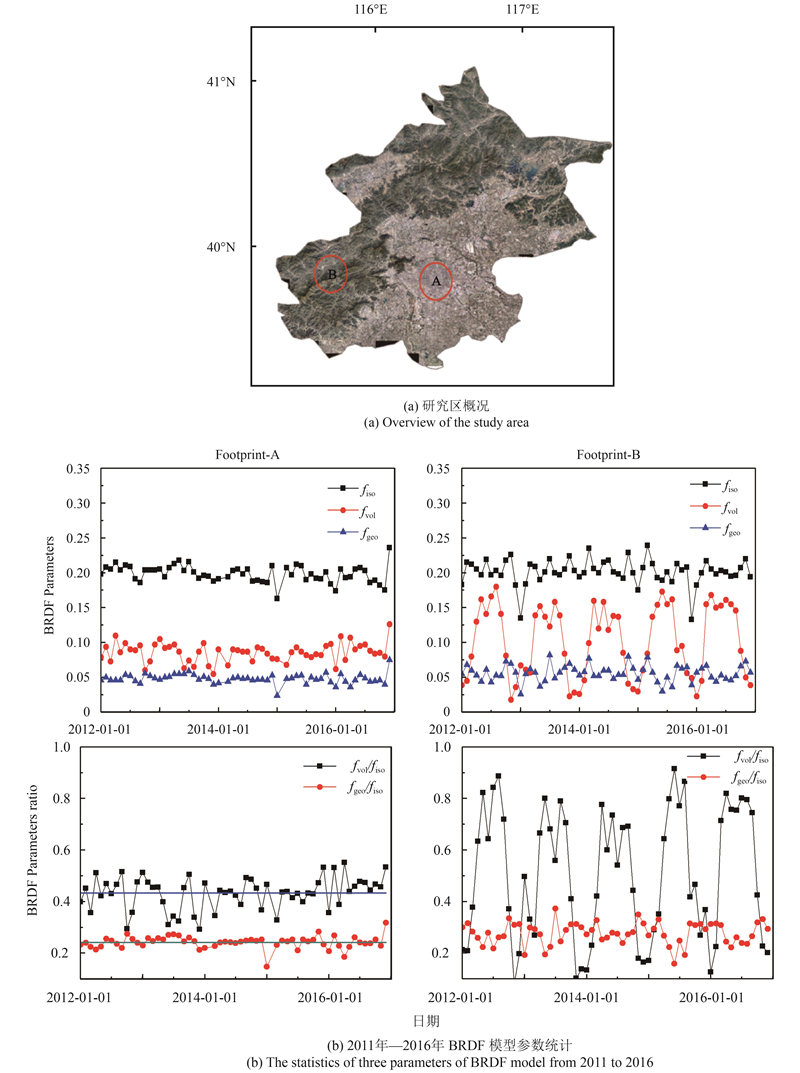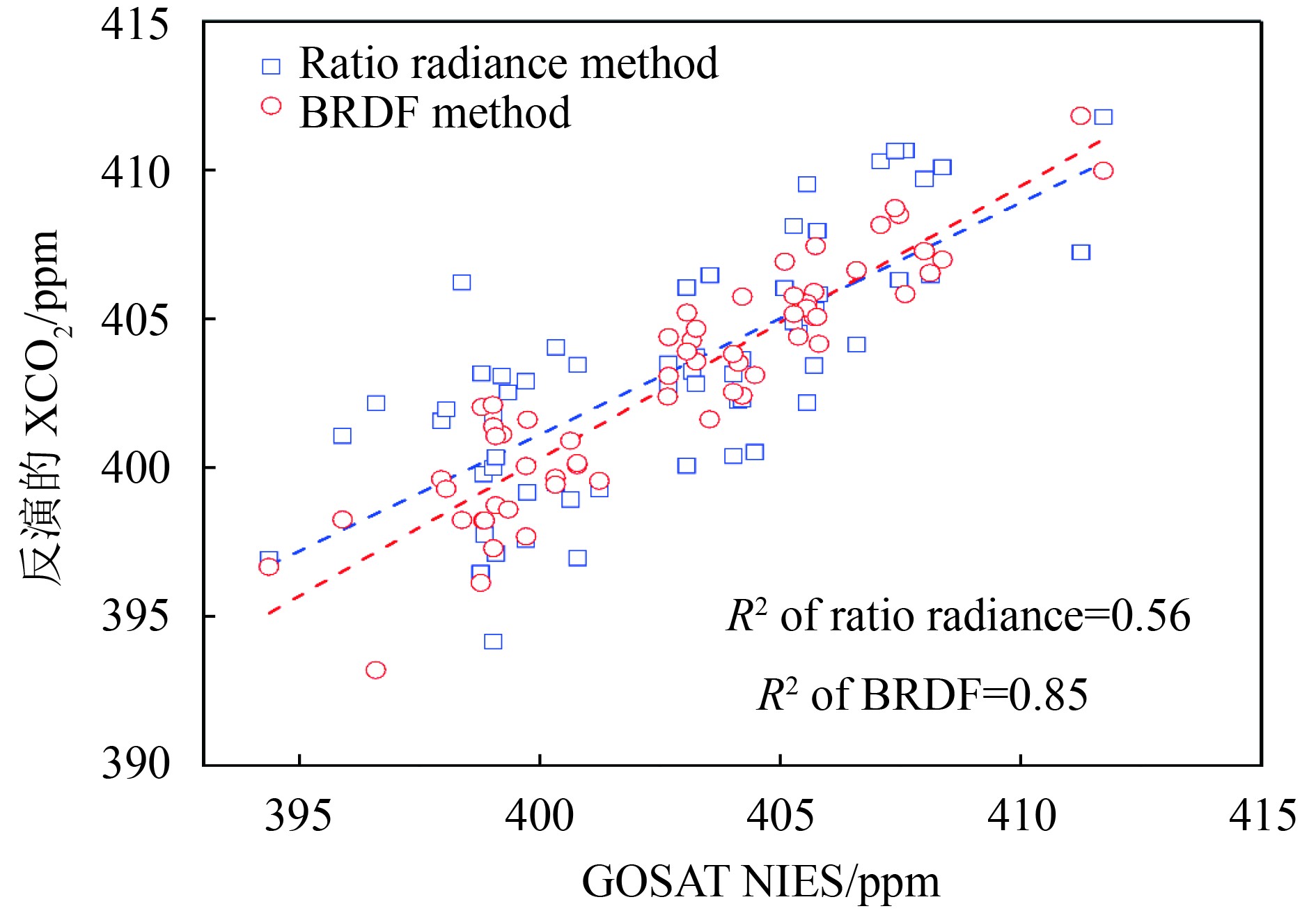| 北京城市下垫面大气CO2反演算法 |
收稿日期: 2018-03-14
2. University of Science and Technology of China, Hefei 230031, China
CO2是大气中主要的温室气体,科学家们普遍认为人为排放的CO2是全球变暖的关键因素(Myhrvold和Caldeira,2012)。世界各国陆续开展了监测大气CO2的研究,相比于地基观测,卫星监测手段具有更广的观测范围,可进行全球范围连续的CO2含量监测,目前在轨的有日本2009年发射的GOSAT卫星(Yokota 等,2009)、美国2014年发射的OCO-2卫星(Hammerling 等,2012)和中国2016年发射的Tansat卫星(Liu 等,2013),在未来2—4年内,还有中国科学院安徽光学精密机械研究所研制的GMI(Wu 等,2018)、日本国立环境研究所研制的GOSAT-2等多颗温室气体监测载荷入轨(Oishi 等,2017)。鉴于大气CO2遥感应用上的需求,对数据反演精度都有很高的要求,日本GOSAT的目标精度为3.8 ppm,美国的OCO-2的目标精度为1—2 ppm,中国GMI的目标精度也为3.8 ppm。高精度大气CO2反演过程中,对地表反射评估不足,会引起较大反演误差。Aben等(2007)利用模拟数据研究指出,当地表反射率从0.1变化到0.5时,反演CO2柱浓度最大会有–5%—5%的误差。O’Dell等(2012)指出,在反演陆地上空XCO2时,将地表假设为朗伯表面,在AOD大于0.25时会出现明显误差。叶函函等(2013)指出,不考虑地表二向反射特性,CO2柱浓度在反演过程中的平均误差为14.53%。城市地区是CO2重要的发射源,对其进行高精度的CO2含量监测有益于控制人为碳排放(Dhakal,2009)。精确反演城市CO2含量,目前的反演方法存在两点不足。一是城市下垫面具有明显的二向反射特性(Friedl 等,2002),将其假设为各向同性的朗伯体无法正确表征地表反射;二是城市大气环境较差,获得理想观测条件(AOD<0.3)的概率低,在高气溶胶值情况下,大气辐射地气耦合复杂。在城市中进行大气CO2的高精度反演,引入地表二向反射模型,有效地校正地表反射成为影响反演精度的关键。
2、基本原理城市下垫面大气CO2反演算法流程图如图1所示。在反演大气CO2含量的过程中,引入城市BRDF模型。城市BRDF模型构建基于Ross-Li地表反射模型,该模型能够较好表征地表二向反射,同时属于核驱动模型反演方便(Shuai 等,2008)。Ross-Li模型的描述见式(1)
| $\begin{aligned} R({\theta _{\rm{s}}},{\theta _{\rm{v}}},\varphi ;\lambda) =& {f_{{\rm{iso}}}}(\lambda){k_{{\rm{iso}}}} + {f_{{\rm{geo}}}}(\lambda){k_{{\rm{geo}}}}({\theta _{\rm{s}}},{\theta _{\rm{v}}},\varphi) + \\& {f_{{\rm{vol}}}}(\lambda){k_{{\rm{vol}}}}({\theta _{\rm{s}}},{\theta _{\rm{v}}},\varphi) \\ \end{aligned}$ | (1) |
式中,
| $\begin{aligned} R({\theta _{\rm{s}}},{\theta _{\rm{v}}},\varphi) = &{f_{{\rm{iso}}}}({k_{{\rm{iso}}}} + f_{{\rm{geo}}}'{k_{{\rm{geo}}}}({\theta _{\rm{s}}},{\theta _{\rm{v}}},\varphi) + \\ & f_{{\rm{vol}}}'{k_{{\rm{vol}}}}({\theta _{\rm{s}}},{\theta _{\rm{v}}},\varphi)) \\ \end{aligned}$ | (2) |
如果式(2)中
| ${{y}} = F ({{x}},{{b}}) + \varepsilon $ | (3) |
式中,
| $\begin{split} J({{x}}) =& {({{y}} - F({{x}}))^{\rm{T}}}{{S}}_\varepsilon ^{ - 1}({{y}} - F({{x}})) + \\ & {({{x}} - {{{x}}_{\rm{a}}})^{\rm{T}}}{{S}}_{\rm{a}}^{ - 1}({{x}} - {{{x}}_{\rm{a}}}) \end{split}$ | (4) |
根据高斯迭代公式(5)求状态向量x的值,使得
| $ \begin{array}{l} {{x}_{\left( {i + 1} \right)}} = {{x}_i}+{\left( {{K}_i^{\rm{T}}{S}_\varepsilon ^{ { - 1} }{{K}_i} + \left( {1 + \gamma } \right){S}_{\rm{a}}^{ { - 1} }} \right)^{ { - 1} }}\\ \left( {{K}_i^{\rm{T}}{S}_\varepsilon ^{ { - 1} }\left( {{y} - F\left( {x} \right) - {S}_{\rm{a}}^{ { - 1} }\left( {{{x}_i} - {{x}_{\rm{a}}}} \right)} \right)} \right) \end{array} $ | (5) |
| ${{{K}}_i} = \partial F({{{x}}_i})/\partial {{{x}}_i}$ | (6) |
式中,

|
| 图 1 GMI数据在城市区域反演流程图 Figure 1 Retrieval of GMI data in urban areas |
|
|
表 1 GMI数据反演过程中状态向量的先验值和协方差矩阵与辅助参数信息 Table 1 State vector, its a priori, the variance covariance matrix and auxiliary parameters for the GMI retrieval |
GMI是GF-5卫星上的重要大气环境监测载荷之一,采用空间外差干涉技术进行高光谱分光,其主要任务是获取O2、CO2和CH4的高光谱探测数据,GMI通道设置和仪器参数如下表2所示。图2(a)红圈模拟了GMI观测点数据在北京市的投影,A为北京城市中心区域,B为郊区山地作为对比点。对A、B两地的地表双向反射研究利用MODIS的BRDF产品。MODIS BRDF数据集包含了7个通道的
|
|
表 2 GMI载荷参数情况 Table 2 Specifications of GMI |

|
| 图 2 北京城区和山地概况和BRDF模型的3个参数统计 Figure 2 The statistics of three parameters of BRDF model in Beijing urban area and mountain area |
从BRDF参数先验数据库,选取1.6 μm通道的数据。北京地区冬季地表会出现积雪,而积雪像元对二向反射率的分析带来较大影响,故对数据进行预处理将包含积雪的像元进行剔除。对预处理后的数据进行空间重采样,得到A、B两地的BRDF核系数(Schmidt 等,2012)。图2(b)统计了2011年—2016年共5年的BRDF等3个核系数的变化规律。可以看出,虽然A城市区域的BRDF等3个核系数随着季节会有改变,
为了定量研究地表二向反射对CO2反演的精度影响,分别使用绝对辐亮度法、比值法(叶函函 等,2013)和BRDF方法反演了GMI模拟数据。3种方法的差异在于绝对辐亮度基于地表反射的朗伯假设,比值法基于波段比值降低反射率不确定度的影响,而BRDF方法是基于地表二向反射的现实。3种反演结果的误差统计如图3所示。图3中太阳天顶角分别为16°,30°,46°和61°,取自不同季节北京地区的正午太阳天顶角,观测二向位于主平面上,观测天顶角依次增大分别为5°、10°、20°、30°、40°、50°、60°和70°。气溶胶的类型为城市型AOD为0.05,模拟用到的地表高程值,大气温度、湿度、压力廓线均来自于欧洲中期天气预报中心ECMWF(The European Centre for Medium-Range Weather Forecasts),地表BRDF参数从BRDF参数先验数据库中提取。

|
| 图 3 绝对辐亮度法、比值法和BRDF方法在不同观测条件下的反演误差(AOD=0.05) Figure 3 The retrieval errors of absolute radiance method, ratio method and BRDF method under different observation conditions (AOD=0.05) |
由于城市地表二向反射,使得观测光谱随着观测角度变化明显,绝对辐亮度法使用固定的地表反射率引入巨大误差,无法获取真实的CO2浓度。比值反演方法是当AOD较小时,忽略气溶胶的散射作用,此时认为观测辐亮度与地表反射率近似成线性,使用特定条件下的光谱点进行比值来消除地表反射的影响。比值反演方法的校正结果如图3中蓝色方形曲线所示,对地表反射率变化引起的CO2反演误差有较好的校正效果,多个观测条件下的最大误差0.8%。对于同时反演BRDF的反演方法如图3中绿色三角形所示,得到的反演结果在各个观测条件下,都非常稳定,很好的校正了地表反射率随着观测几何变化带来的反演误差,误差均小于0.1%。
在忽略气溶胶散射或者气溶胶散射作用较小的情况下,比值反演方法和BRDF方法均可较好地校正地表反射二向特性引入的反演误差。然而针对北京城区的大气条件,仅反演小值AOD观测数据,数据的利用率将大幅降低(张晗 等,2017)。改变模拟数据AOD值为0.4,其他条件设置与上文一致,比值法和BRDF方法反演结果如图4所示。当AOD较大时,卫星观测辐射强度与地表反射率呈近似线性关系的假设不成立。如图4(a)所示,比值法的反演结果在后向观测区域,反演误差平均为–1.26%,随着太阳天顶角增大,反演误差增大。在天顶角较大的时候,CO2的吸收光程较长,受到气溶胶散射的影响更大。在前向观测区域,随着太阳天顶角的增大,反演误差先减小后增大;随着观测天顶角的增加,反演误差也先减小后迅速增大。最大的反演误差可以达到4.75%。此时使用比值方法无法获取满足精度要求的反演结果。

|
| 图 4 比值法和BRDF方法在不同观测条件下的反演误差(AOD=0.4) Figure 4 The retrieval errors of ratio method and BRDF method under different observation conditions (AOD=0.4) |
由于同时反演了BRDF参数,图4(b)中结果显示气溶胶和地表反射耦合作用带来的反演误差被较好地校正。在观测天顶角小于50°时,反演结果稳定,误差几乎不随着天顶角变化而变化。在太阳天顶角小于30°时,校正效果最好,反演误差稳定,除了两端观测天顶角大于60°时,误差达到0.5%,其他误差均在0.1%之内。当太阳天顶角大于30°后,反演结果也比较稳定,但是反演误差增大,当太阳天地角为61°时,平均的反演误差为0.75%,而最大的反演误差出现在观测天顶角为70°时,误差为1.25%。模拟数据反演结果证明,同时反演BRDF的方法可以很好的校正由于地表二向反射而造成CO2反演误差,尤其是在AOD较大的时候,这种校正对于获取精确的大气CO2含量尤为重要。
为了检验该方法的实际效果,筛选2016年全年北京城市区域有GOSAT二级产品的数据点进行反演,反演中以GMI光谱带宽对GOSAT的光谱进行截断,以适应GMI反演算法的需要。结果如下图5所示,图5(a)、(b)、(c)、(d)分别为春季,夏季,秋季和冬季的反演结果,图5中蓝色线条为GOSAT NIES算法的反演结果加上误差修正作为BRDF方法反演结果的参考值。黑色三角点为比值法的反演结果,红色圆点为BRDF方法的反演结果,图5中黑色区域为参考值的0.5%误差范围,从图5上看,几乎所有BRDF方法的反演结果都在参考值的误差范围内。在北京地区春季和夏季,比值法反演多次超过误差范围,分析对应的AOD值,发现这些观测数据的AOD值都接近或大于0.3,而利用BRDF方法反演,对于这些点的反演结果都与参考值更为接近,且位于0.5%的误差范围内。统计了比值法和BRDF方法与参考值的相关性,如图6所示。其中比值法的总体相关性为0.56,而通过BRDF方法反演,其相关性升高为0.85。表3分别统计了2016年4个季节,比值反演法和BRDF方法的反演结果与参考值的相对误差均值、标准差和相关系数。从表3中对比可以看出,BRDF方法的相对误差均值和离散程度均较小。注意到2016年夏季,比值法和BRDF方法的反演结果与参考值的相关性都较差,分析这些异常点的原因主要是在较高的AOD的情况下(大于0.3),反演时气溶胶模式假设不准确造成的。

|
| 图 5 2016年北京城市区域比值法和BRDF方法的反演结果 Figure 5 Retrieved XCO2 of ratio method and BRDF method in Beijing urban area during 2016 |

|
| 图 6 2016年北京城市区域比值法和BRDF方法的反演结果与GOSAT参考值的相关系数 Figure 6 Correlation of ratio method and BRDF method retrieval results with GOSAT reference values in Beijing urban area during 2016 |
|
|
表 3 2016年4个季节比值法和BRDF方法的相对误差均值、相对误差标准差和相关系数 Table 3 Mean value, standard error and correlation coefficient of ratio method and BRDF method of each season in 2016 |
城市下垫面方向反射对大气CO2反演结果的精度影响显著,如果不对其进行校正,将无法获取高精度CO2的浓度信息。本文统计了北京地区MODIS BRDF数据,构建了BRDF参数初值数据库。通过分析城市下垫面的BRDF特性,确定了城市BRDF模型参数。基于此提出反演CO2含量的同时反演地表BRDF参数的算法,可以有效校正地表二向反射和地气耦合带来的反演误差。结果表明:(1)对于GMI模拟数据,在AOD值为0.05的情况下,其CO2反演误差可以控制在0.1%(~0.4 ppm);当AOD值为0.4时,CO2反演误差大部分控制在0.5%(~2 ppm)。(2)应用在GOSAT实测数据上,与修正的GOSAT NIES反演结果相比,2016年全年的平均误差为1.25 ppm,相关性达到0.85。该算法的提出,为高精度反演北京城区大气CO2含量提供保障。同时对复杂地表环境和高值气溶胶条件下,大气CO2的反演提供了参考。
该算法对于GMI实测数据的反演效果,需要获得GMI在轨数据后进行进一步的评估。由于北京地区并无TCCON站点,在进行GMI数据的实际反演过程中,需要开展地面测量来验证反演精度和方法改进。同时注意到,对于城市这一气溶胶条件复杂的区域,更准确的气溶胶模型和气溶胶多参数的同时探测与联合反演会进一步提高城市地区大气CO2的反演精度。为目前和下一代,大气CO2监测载荷数据处理提供高精度反演算法。
| [1] | Aben I, Hasekamp O and Hartmann W. Uncertainties in the space-based measurements of CO2 columns due to scattering in the Earth’s atmosphere [J]. Journal of Quantitative Spectroscopy and Radiative Transfer, 2007, 104 (3) : 450 –459. DOI: 10.1016/j.jqsrt.2006.09.013 |
| [2] | Dhakal S. Urban energy use and carbon emissions from cities in China and policy implications[J]. Energy Policy, 2009, 37 (11) : 4208 –4219. DOI: 10.1016/j.enpol.2009.05.020 |
| [3] | Friedl M A, McIver D K, Hodges J C F, Zhang X Y, Muchoney D, Strahler A H, Woodcock C E, Gopal S, Schneider A, Cooper A, Baccini A, Gao F and Schaaf C. Global land cover mapping from MODIS: algorithms and early results[J]. Remote Sensing of Environment, 2002, 83 (1/2) : 287 –302. DOI: 10.1016/S0034-4257(02)00078-0 |
| [4] | Hammerling D M, Michalak A M and Kawa S R. Mapping of CO2 at high spatiotemporal resolution using satellite observations: global distributions from OCO‐2 [J]. Journal of Geophysical Research: Atmospheres, 2012, 117 (D6) : D06306 . DOI: 10.1029/2011jd017015 |
| [5] | Liu Y, Yang D X and Cai Z N. A retrieval algorithm for TanSat XCO2 observation: retrieval experiments using GOSAT data [J]. Chinese Science Bulletin, 2013, 58 (13) : 1520 –1523. DOI: 10.1007/s11434-013-5680-y |
| [6] | Myhrvold N P and Caldeira K. Greenhouse gases, climate change and the transition from coal to low-carbon electricity[J]. Environmental Research Letters, 2012, 7 (1) : 014019 . DOI: 10.1088/1748-9326/7/1/014019 |
| [7] | O’Dell C W, Connor B, Bösch H, O’Brien D, Frankenberg C, Castano R, Christi M, Eldering D, Fisher B, Gunson M, McDuffie J, Miller C E, Natraj V, Oyafuso F, Polonsky I, Smyth M, Taylor T, Toon G C, Wennberg P O and Wunch D. The ACOS CO2 retrieval algorithm-Part 1: description and validation against synthetic observations [J]. Atmospheric Measurement Techniques, 2012, 5 (1) : 99 –121. DOI: 10.5194/amtd-4-6097-2011 |
| [8] | Oishi Y, Ishida H, Nakajima T Y, Nakamura R and Matsunaga T. The impact of different support vectors on GOSAT-2 CAI-2 L2 cloud discrimination[J]. Remote Sensing, 2017, 9 (12) : 1236 . DOI: 10.3390/rs9121236 |
| [9] | Schmidt M, Udelhoven T, Röder A and Gill T K. Long term data fusion for a dense time series analysis with MODIS and Landsat imagery in an Australian Savanna[J]. Journal of Applied Remote Sensing, 2012, 6 (1) : 063512 . DOI: 10.1117/1.jrs.6.063512 |
| [10] | Shuai Y M, Schaaf C B, Strahler A H, Liu J C and Jiao Z T. Quality assessment of BRDF/albedo retrievals in MODIS operational system[J]. Geophysical Research Letters, 2008, 35 (5) : L05407 . DOI: 10.1029/2007gl032568 |
| [11] | 王开存, 王建凯, 王普才, 陈洪滨. 用MODIS反演北京城市地区地表反照率精度以及算法改进[J]. 大气科学, 2008, 32 (1) : 67 –74. Wang K C, Wang J K, Wang P C and Chen H B. The accuracy of MODIS albedo over Beijing Urban area and its algorithm improvement[J]. Chinese Journal of Atmospheric Sciences, 2008, 32 (1) : 67 –74. DOI: 10.3878/j.issn.1006-9895.2008.01.06 |
| [12] | Wu H, Wang X H, Ye H H, Jiang Y and Duan F H. Error analysis of the greenhouse-gases monitor instrument short wave infrared XCO2 retrieval algorithm [J]. Journal of Applied Remote Sensing, 2018, 12 (1) : 016015 . DOI: 10.1117/1.jrs.12.016015 |
| [13] | 叶函函, 王先华, 吴军, 方勇华, 麻金继, 江新华, 韦秋叶. 大气CO2反演的地表反射率影响分析与比值反演方法 [J]. 光谱学与光谱分析, 2013, 33 (8) : 2182 –2187. Ye H H, Wang X H, Wu J, Fang Y H, Ma J J, Jiang X H and Wei Q Y. Study of the effect of surface reflectance on atmospheric CO2 retrieval and ratio spectrometry [J]. Spectroscopy and Spectral Analysis, 2013, 33 (8) : 2182 –2187. DOI: 10.3964/j.issn.1000-0593(2013)08-2182-06 |
| [14] | Yokota T, Yoshida Y, Eguchi N, Ota Y, Tanaka T, Watanabe H and Maksyutov S. Global concentrations of CO2 and CH4 retrieved from GOSAT: first preliminary results [J]. Sola, 2009, 5 : 160 –163. DOI: 10.2151/sola.2009-041 |
| [15] | 张虎, 焦子锑, 董亚东, 李佳悦, 李小文. 利用BRDF原型和单方向反射率数据估算地表反照率[J]. 遥感学报, 2015, 19 (3) : 355 –367. Zhang H, Jiao Z T, Dong Y D, Li J Y and Li X W. Albedo retrieved from BRDF archetype and surface directional reflectance[J]. Journal of Remote Sensing, 2015, 19 (3) : 355 –367. |
| [16] | 张晗, 余超, 苏林, 李令军, 范萌, 王雅鹏, 陈良富. MODIS和OMI数据评估阅兵期间北京市大气减排成效[J]. 遥感学报, 2017, 21 (4) : 622 –632. Zhang H, Yu C, Su L, Li L J, Fan M, Wang Y P and Chen L F. Emission control effects observed from space during the military parade 2015 in Beijing[J]. Journal of Remote Sensing, 2017, 21 (4) : 622 –632. |


